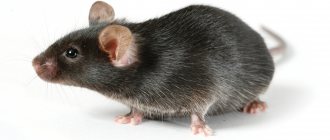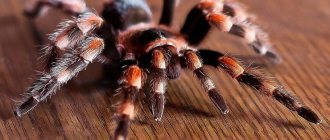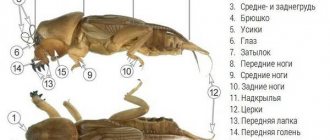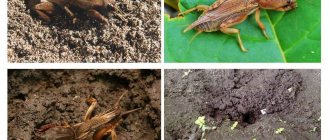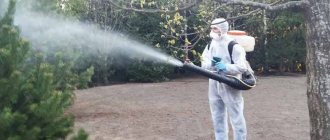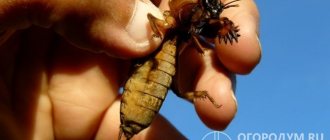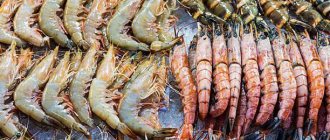Origin of the species and description
Photo: Medvedka
The mole cricket is a large insect. People's love for cabbage earned it the nickname cabbage or earthen crayfish. The mole cricket is included in a number of rectangular arthropods, long-whiskered insects, the superfamily Cricketidae, the mole cricket family, and the mole cricket subfamily.
The insect received its scientific name due to its large size and brownish-brown color. The terrifying appearance of a large insect with massive clawed paws resembles a bear. In their natural habitat, scientists have counted up to 110 species of the family of mole crickets Gryllotalpidae, very similar to each other in lifestyle and appearance. The common mole cricket species is most widespread throughout the planet.
Video: Medvedka
Gryllotalpa, the mole cricket's name in Latin, translates to mole cricket. The insect is endowed with the habits of a mole, because it spends most of its life in the ground and digs holes there. But what they have in common with a cricket is the ability to produce a sound reminiscent of a chirp.
Distinctive features of the bear:
- usually the body length of the insect is 5 cm, but there are species with larger dimensions;
- the insect's front legs are formed in the form of powerful claws for digging;
- nature has endowed it with powerful jaws. There is no danger to humans;
- can dig holes and fly. Makes flights only in warm weather;
- They make chirping sounds by rubbing their wings during the mating season. Males attract females in this way.
Interesting fact: Medvedka has the skills of an excellent swimmer. Able to swim long distances and overcome obstacles in water.
Methods of dealing with mole crickets
Small mounds of rolled up lumps of soil will tell you about the presence of a mole cricket on your property or in the garden. In these places, plants wither and die.
It is possible to remove mole crickets, but to do this, you should choose an integrated approach and carry out measures to combat this pest in three directions throughout the year. Firstly, protect plants from insects, secondly, use mechanical methods to catch insects and destroy clutches of their eggs, and thirdly, protect your site from the penetration of new individuals.
The use of chemical insecticides is recommended only as a last resort. With due persistence, you can cope with mole crickets without them, without poisoning the earth with carcinogens.
To prevent a mole cricket from getting to you from another area, you should fence your territory around the perimeter. You can make a fence from sheets of tin or slate 30-50 cm high, burying them 50-60 cm deep in the ground. Instead of a fence, you can dig a groove around the perimeter to the same depth and fill it with sand or sand moistened with kerosene (one tablespoon of kerosene per bucket of sand).
The smell of kerosene repels the pest, and the mole cricket's passages in the sand simply collapse. You can also fill the groove with broken bricks or crushed stone.
In early spring and autumn, the soil should be deeply plowed, and deep loosening of the soil should be carried out throughout the season. In this way, underground tunnels, nests with eggs and stray larvae are destroyed.
In the spring, bait is made for mole crickets from eggshells, ground in a coffee grinder and soaked in sunflower oil. It is important to use bait in early spring, before the first shoots appear, since later the mole cricket will prefer tender plants to it. This mixture can be placed in holes and furrows directly with the seeds during planting. A mole cricket, having eaten such bait, dies.
Also in the spring, during the mating season of mole crickets, you can prepare shallow holes and fill them with manure. Or simply spread small piles of manure around the area.
Mole crickets crawl into manure and lay eggs there. After about a month, the manure along with the larvae is burned.
In the summer, when weeding and loosening the soil, you can find the holes in the mole cricket's passages. They must be filled with a soap solution (10g of laundry soap, 50g of washing powder per bucket of water) or a mixture of water and kerosene (100g per 10l of water) in a volume of 0.5l per stroke. After some time, the mole cricket dies underground or comes to the surface, where it must be collected and destroyed.
Traps for mole crickets
Good results are obtained by using a variety of traps. You can easily make such traps yourself. Typically, half-liter glass jars are used for traps, which are buried up to the neck in the ground.
The jars are filled with water, leaving 4-8 cm to the edge, so that a mole cricket that gets into it cannot get out. As a bait, you can coat the inside of the jar with honey, or you can place chopped potato tubers in it.
Instead of water, you can pour a little beer into the jar, its smell will lure the mole cricket. It is important to regularly check traps and destroy insects that have crawled into them.
In the fall, until the ground temperature drops below +8 degrees, you should dig two holes for every 100 square meters, 50-60 cm deep, cover them with plastic film and fill them with fresh horse or cow manure, sprinkle with earth on top. The mole cricket will climb into the warm, humid manure for the winter.
It is important to have time to prepare such traps before the soil temperature drops to +5 degrees, because with the onset of cold weather, mole crickets become inactive and go deeper into the ground. After the onset of stable frosts, manure along with insects is scattered on the ground, and mole crickets die from the cold.
To better preserve the crop, along with catching and destroying mole crickets, plant protection measures should be taken. When planting seedlings of peppers, tomatoes, and eggplants, various barriers are used around the plant stem.
For example, pieces of rubber hoses, plastic bottles, cans from canned food, nylon mesh. It is important that the fence protrudes 2-3 cm above the soil surface.
Before planting blackberries on your plot, find out their varieties. Blackberry varieties.
Specifics of caring for gooseberries: https://rusfermer.net/sad/yagodnyj-sad/posadka-yagod/kryzhovnik-kak-pravilno-vysazhivat-uhazhivat-i-lechit.html
Appearance and features
Photo: What a bear looks like
Mole crickets are quite large insects. The length of their body can reach from 3.5 to 5 cm, and the width - from 1.1 to 1.6 cm. On the outside, the body of the mole cricket is colored brown with an admixture of brown, and the inside is yellow with a hint of brown. The entire body of the cabbage plant is covered with small hairs. The insect's head is on the same axis with the body, that is, the body is its continuation. In the front of the head, the mole cricket has powerful jaws. Next to the jaws there are two pairs of tentacles.
The eyes of mole crickets have a faceted structure and are clearly visible on the head. On the head there are thread-like whiskers that extend behind the front back. The pronotum of a mole cricket is a distinctive feature of the insect. The insect's head and front part of the body are covered with a dense shell and a special device for pushing and compacting the earth while digging. The abdomen of mole crickets is quite thick, about 1 cm in diameter. The anal and genital plates are located on its upper part.
By nature, cabbage mushrooms do not lay eggs. On the last segment of the abdomen, mole crickets have special appendages that resemble small antennae in appearance. All mole crickets have two pairs of wings. Females differ from males by different veins on their wings. There are also individuals without wings, but these are extremely rare. The so-called “ears” of mole crickets, as well as other individuals belonging to its subspecies, are narrow and elongated, and are located on the shins of the front legs. The insect's hind legs have several spines and are designed for movement, and the front legs are powerful, have tentacles and are designed for digging trenches and holes.
Types of mole crickets
There are several different species that practically do not differ from each other: they have the same lifestyle, taste preferences and appearance. The difference can only be noticed if you examine their chromosome set. There are about 110 species in total, among the known ones are the following: Common - one of the largest groups that is widespread in Europe.
Damages all types of grains and agricultural crops. African - grows up to 3.5 cm, body color is dark yellow, closer to brown. The abdomen is light yellow. It has small thread-like antennae. Ten-fingered - the species is widely represented in the USA and Canada. The size is from 2 to 3.5 cm. In its natural habitat it has an enemy - the ground wasp, it penetrates the mink and paralyzes with its sting.
The Far Eastern mole cricket is morphologically close to the common mole cricket and is distributed in China, Vietnam, Japan and the Sakhalin region. Single-spike - differs from other species in that the thickness of its body is narrower, and the front wings have not very pronounced transverse veins. The length of a mature individual reaches 4.5 cm. And the steppe mole cricket, which lives in the south of Russia, Ukraine and a number of other countries, is also quite famous.
Where does the bear live?
Photo: Medvedka in Russia
The insect's habitat is quite extensive. The mole cricket is unpretentious, the only thing it is afraid of is frost, and the desert is also not suitable for it to live in. It inhabits almost the entire territory of Eurasia except the Scandinavian countries, North Africa, both Americas, and Australia. But it did not conquer Antarctica and the northern Arctic territories.
Favorable places for mole crickets to live are meadows and river floodplains. Insects prefer damp areas. Underground passages, wetlands and irrigation canals are favorite habitats. It is also easy to find mole crickets in melon and melon fields, as well as in places that are characterized by deep groundwater.
Any type of soil is suitable for mole crickets to live in; the best option is loose, warm and moist soil, saturated with organic fertilizers. Under the ground, the insect digs passages that create an entire system that performs transport, protective and ventilation functions.
Interesting fact: The mole cricket digs holes of a perfectly regular oval shape.
In a humid habitat, the mole cricket spreads very quickly. But if the habitat becomes no longer inhabitable for it, the mole cricket is forced to move to a new territory. It often moves at night on water, land or air.
Interesting fact: Medvedka loves to live in dung heaps. An excellent option for them is well-heated wet manure (mullein).
Now you know where the mole cricket is found. Let's see what she eats.
Harm from the mole cricket
Mole cricket is a serious fruit pest. While making their passages, insects chew through everything in their path. They tear the roots and spoil the stems of all garden crops. The mole cricket eats seeds and gnaws root crops.
Due to the underground lifestyle of pests, birds do not affect their population numbers, and adult insects are quite fertile. During the season, the female lays from 200 to 600 eggs.
In search of favorable living conditions, mole crickets are able to move long distances.
They love to settle in gardens and areas with moist, manured, loose soil, with a high content of humus.
What does a bear eat?
Photo: Mole cricket insect
The mole cricket is an omnivorous insect, its gluttony resembles a locust. She does not disdain weeds, small insects and spineless ones.
Feeding characteristics of mole crickets:
- are distinguished by greed, which causes enormous damage to the crop;
- destroy plantings of tomatoes, potatoes, cabbage, legumes and melons;
- per day one individual can gnaw up to 15 plants;
- The larvae eat the crops that the adults did not have time to eat.
Mole crickets eat all parts of plants: roots, aerial parts, seeds. In the forest, the insect feeds on the roots of young seedlings of trees and bushes; in summer cottages, all plantings are eaten. They don’t even disdain exotic citrus fruits (oranges, tangerines, lemons).
The main food products of mole crickets are:
- vegetables: potatoes, cabbage, tomatoes, cucumbers, peppers, corn;
- sowing of grain crops, soybeans, rice, buckwheat;
- roots of young trees: apple, oak, pine, cherry.
It is a mistaken belief that mole crickets are vegetarians. 40% of their food consists of living things. They can eat earthworms and small insects and larvae.
Interesting fact: Cabbage can be beneficial for humans. It exterminates some types of harmful insects, such as the Colorado potato beetle.
In exceptional cases, a mole cricket can become a cannibal when there is an acute shortage of food.
Interesting facts about mole cricket
- Gourmets in South-East Asia sometimes consume these insects as a delicacy. Moreover, they are prepared fried, stewed, pickled, with the addition of seasonings or even without them.
- Sometimes the mole cricket brings some benefit, as it destroys the larvae of cockchafers and some other insects that eat plants
- Surprisingly enough, there are benefits from Medvedka in the field of pharmaceuticals as well. So a powder is made from it, which is used as one of the components for a cure for tuberculosis.
Features of character and lifestyle
Photo: Mole cricket beetle
Insects can be classified as active animals. The cabbage burrows, swims and moves quite quickly. The only thing she does slowly is fly. She mainly makes flights to find a male for mating.
The mole cricket has a good habit of adapting to its environment. By nature this insect is a mole rat. The mole cricket spends most of its life underground. During the day, she lives underground, digging tunnels in the upper layers of the soil, destroying all plantings that come across her path. At night, it comes to the surface in order to change its habitat and find new sources of food.
At first glance, it is difficult to accurately determine the presence of a mole cricket in a garden plot. But if you study the soil in more detail, the presence of holes and loosened rollers on the ground indicates the vigorous activity of the mole cricket. Consequently, in the near future, plantings in its habitat will die.
In search of food, insects can cross large areas of land, fly through the air, or swim. The insect was forced to learn to swim, since in the spring its habitat is often flooded with flood water. The mole cricket is afraid of frost, so in winter it descends through burrows into the depths, moving to a depth of 1 m. To where the ground does not freeze. Mole cricket larvae can overwinter at a depth of 50 cm.
Mole cricket in greenhouses
Earthen crayfish can be found not only in open ground, but also in greenhouses, and even in greenhouses. And if insects appear in the garden only in the spring, then in greenhouses they can become active even in the cold season.
Therefore, before planting a greenhouse, you should not neglect preventive measures to combat the mole cricket. The simplest and most productive is the arrangement of a barrier strip along the entire perimeter of the building. Sheets of slate, polycarbonate or metal, buried to a depth of 50–60 cm, are ideal for this purpose.
However, this method is not acceptable for all greenhouses. A line of insurmountable obstacles for pests can be created by burying eggshells or poisonous baits around the perimeter.
Earthen crayfish can get into the greenhouse not only through an underground tunnel. Very often, gardeners themselves bring in nymphs or clutches along with compost and manure. In this case, measures to combat mole crickets come down to the same algorithm as in open ground. By regularly repeating a number of the same actions, you can get rid of it forever.
Social structure and reproduction
Photo: Medvedka in the garden
After wintering and emerging from their burrows to the surface, mole crickets begin the first stage of reproduction. In the spring, having chosen a mate, mole crickets return to their burrows to mate. The offspring appear in the summer. Preparing for future offspring takes a lot of time for male and female mole crickets, as they are extremely careful about this. The pair digs large ornate tunnels at a depth of about five centimeters underground, and creates spherical nests with a diameter of up to ten centimeters, in which the female subsequently lays eggs, from three hundred to six hundred pieces.
All the time during the process of maturation of the eggs, the female does not leave the nest, taking care of them. It restores collapsed passages, cleans them of roots, and also controls the temperature necessary for eggs. This whole process is extremely important for the future offspring of mole crickets. Mole cricket eggs look like millet grains; they are oblong, yellow with a gray tint and about two centimeters in size. After twenty days, the larvae hatch, which resemble small creatures with six gray legs. The larvae are small though.
But outwardly similar to adults. After birth, for twenty to thirty days, the female mole cricket, as befits a mother, takes care of the cubs and protects them. At the end of this period, the female dies, and the grown and mature mole crickets crawl into their burrows and begin an independent life. From hatchling to full adult, the maturation process takes from one to two and a half years.
How to get rid of mole crickets in the garden using ready-made products
Fighting mole crickets in the garden with the help of chemicals can be detrimental to the composition and fertility of the soil. In addition, cultivated plants growing nearby are severely affected. These measures are extreme and are used in case of a strong concentration of insects in a personal plot. Regardless of the type and class of hazard, it is recommended to adhere to the following safety and protection measures when using:
- Avoid the presence of children and animals in the treated area. Fumes of poisons negatively affect the nervous system of living organisms.
- Use all protective measures: gloves, closed clothing, special respirator. All containers and objects that come into contact with insecticides must be isolated. Make sure that children and animals do not reach them.
- Strict adherence to drug concentrations is important. Carefully read the attached instructions for use.
Below are the most effective remedies for mole crickets in the garden that will help eliminate pests forever.
Antimedvedka
Range of action. Protects vegetable crops, ornamental plantings, shrubs and trees. The action is based on attracting insects and then eating the poison. It blocks their nervous system, causing paralysis.
Release form . Packages with microgranules, packaged in 250 or 300 g.
Active substance . Imedacloprid.
Mode of application . At a distance of 10 cm from the plants or the intended place for planting seedlings, make holes 2-5 cm deep. Pour a teaspoon of the drug into them. Possible use in the discovered habitats of earthen crayfish.
Efficiency . The duration of the drug is 2-3 weeks. After this time, it is necessary to re-process.
Chops
Release form . Brown and green granules.
Active substance . Fipronil.
Mode of application . Similar to other granular products, it is scattered into depressions in the soil near the planted plants or the intended planting site.
Efficiency . Not resistant to moisture and sunlight. Maintains effect for two weeks.
Grizzly
Spectrum of action . It is not a phytotoxic agent, therefore it is used in vegetable, fruit and berry plantings. The effect is achieved 2 days after the pest enters the body.
Release form . Plastic packages containing brown granules that require subsequent grinding. Weight is 20 g.
Active substance . Diazonin and other compounds that attract cabbage weeds and other pests.
Mode of application . Several granules of the drug are placed in holes 5 cm deep. Treatment is carried out in the spring, in the places where vegetables and other crops are supposed to be planted.
Efficiency . The action continues for several weeks. However, unfavorable weather conditions can reduce the protective properties of the drug.
Medvetox
Spectrum of action . Effectively fights mole crickets by blocking nerve impulses. The effect appears as soon as possible after treatment.
Release form . Packages with 30 or 100 gr. chemical.
Active substance . Diazonin.
Mode of application . Place the granules in shallow holes, and then pour plenty of water.
Efficiency. The action lasts about 3 months. Differs in weak dependence on weather conditions.
Wofatox
Spectrum of action . Destroys all pests living on the land. It is highly effective - within a few hours it leads to death of adults and larvae.
Release form . Powder or ampoules with liquid product.
Active substance . Bifenthrin and imedacloprid.
Mode of application .
Depending on the type of product, it is used strictly according to the instructions. The peak of action lasts for 15 days. Afterwards, the effectiveness gradually decreases. Complete disintegration after 45 days.
Natural enemies of mole crickets
Photo: What a bear looks like
The insect's main enemies are birds, but not all of them can find a mole cricket underground. But rooks can do this. To do this, they have a powerful beak, with which they tear off mole crickets and their larvae. Starlings and hoopoes are also capable of searching for mole crickets. In swampy areas, the main enemy of the insect is the stork.
Mole crickets are also afraid of some animals:
- hedgehog;
- shrews;
- mole;
- lizards.
Some types of insects also do a good job of destroying the mole cricket population:
- ants that destroy mole cricket eggs;
- ground beetle that eats larvae.
The causative agent of fungal diseases poses a particular danger to the mole cricket population. One of these diseases is caused by Beauveria bassiana, an entomopathogenic fungus that grows in the body of the mole cricket and, releasing toxins, causes the death of the insect.
Interesting fact: The mole cricket becomes a carrier of Larra wasp eggs. To do this, the wasp drives the insect out of the hole, stings, paralyzing the mole cricket, and then lays an egg in its body. After a while, the mole cricket comes to its senses and returns to its hole. Gradually, the wasp larva devours the mole cricket from the inside.
Pets, in particular cats, also do not hesitate to eat mole crickets. They hunt insects like rodents. People not only exterminate mole crickets because they harm agricultural plants. Some gourmets eat insects. They are stewed, fried and even pickled. Medvedok is used in pharmaceuticals. Powdered mole crickets are added to the medicine for tuberculosis.
Folk remedies against mole crickets
Traditional methods also help against mole crickets, but their main purpose is to scare away the insect, using its vulnerabilities, especially sensitivity to strong odors. Therefore, it is good to use the products of grandparents in combination with chemicals.
Cotton swabs with essential oils
In Kuban, this method is used to scare mole crickets away from cucumbers, beans, beets and other crops, which, when sown in open ground, are placed at a distance from each other. The essence of the method is to create an aromatic barrier that the mole cricket will not go against.
Cotton swabs are soaked in essential oils or sharp-smelling substances:
- clove oil;
- eucalyptus;
- valerian;
- turpentine;
- birch tar.
Cotton swabs are stuck into the ground with the soaked side down so that a triangle is formed around the defeated seed. You can also use it in rows, placing the repellent at intervals of 15-20 cm from each other.
According to reviews, such protection works for at least a month, during which time many plants manage to sprout and get stronger.
Bread with matches
This is the way to destroy mole crickets. To prepare the bait, moisten black bread and roll the resulting slurry into balls the size of a quail egg. Next, stick matches into the crumb with the sulfur heads inward, for one ball there are at least 19 matches.
Under the influence of moisture, the sulfur heads will soften, now you can remove the matches, but the sulfur will remain inside. A mole cricket, eating bread, will be poisoned by sulfur and die. Baits are placed in close proximity to holes and passages, preferably in the evening.
Soap and oil water
The mole cricket has a hard shell, but it easily allows various substances to pass through, while breathing is carried out by the whole body. You can play on this by preparing a soap solution (100 g of crushed laundry or tar soap per 10 liters of water). The resulting solution is used to water the norms of the mole cricket. Usually the insect, escaping from the alkali, jumps out, where it can be killed with a blow from a shovel.
Another option is to mix water and oil in a 1:1 ratio. Here you don’t even have to kill the insects: the oil film tightly envelops the mole cricket’s body, depriving it of oxygen. The product is also watered along the passages or poured directly into the holes.
Eggshell
For mole crickets, eggshells are not dangerous until they enter the intestinal tract. Here, sharp granules damage the shells, which leads to the death of the harmful insect. The method is simple - grind the shells into powder and scatter them into the holes before planting the seedlings.
You can sprinkle a thin layer into the furrows before sowing seeds. Additionally, eggshells will be a good fertilizer.
Nutrition
Food preference depends on the species of Orthoptera. Some of them are vegetarians, some prefer insects, while most are omnivores. Mole crickets do not climb the trunks of trees and bushes; these garden pests prefer to eat the roots and young shoots of plants, as well as fruits growing above the ground or fallen fruits, dragging them into a burrow.
They do not choose between weeds and cultivated varieties, but gnaw everything. Young growth prefers root crops and tender roots of seedlings; older ones will not let worms and larvae pass by. They can eat their own kind. Mole crickets have a special passion for cabbage.
Knowing what an insect eats and what it likes, summer residents often set up unique traps for pests, trying to get rid of them.
Medvedka as a medicine
No matter how scary the mole cricket looks, it turns out to be a very useful insect. Traditional medicine claims: the use of mole crickets as a medicine is recognized today as a very effective remedy in the treatment of pulmonary tuberculosis! The body of these insects contains an enzyme that destroys the waxy shell of Koch's bacillus. In addition, it contains various minerals and vitamins, so preparations from mole crickets are easily absorbed by the patient’s body.
Here is one of the recipes:
Grind 30 g of dried mole cricket into powder, divide into 9 equal parts (3.3 grams each) - this amount is enough for one 3-day course. Take 3 times a day 15 minutes before meals, 1 part (3.3 g), mixed with sugar syrup or honey, with water. Treatment involves 3-6 courses with a break of 10 days.
That's it, bear!
Where and how does the mole cricket winter?
Mole cricket larvae of 2-6 instars (implying 2-6 molts) and adults overwinter in soil, humus or manure. They burrow much deeper into the ground than in summer. The larvae deepen by 25 cm, adults - by 60, and sometimes 100-120 cm. They make winter depressions at an angle of 45 to 60 degrees. After wintering, mole crickets come to the surface when the soil temperature reaches 12-15 degrees.
Nest
The insect's nest is truly unique! It is represented by a small underground space at a depth of 10-15 cm. There are passages dug around the “family hearth” and there are four exits to the surface along the edges.
The female laying eggs is able to close and open these passages, thereby regulating the temperature and humidity in the nest, creating the best conditions for the development of eggs and newborn larvae.
In the nest, the female gnaws the roots of plants, thereby destroying all vegetation on the surface so that the sun warms this area of the ground as much as possible.
Mole cricket as food
Medvedka has long been a traditional dish in many Asian countries: China, Thailand, Vietnam and the Philippines. Mole crickets are a delicacy in Mexico and some African countries. Medvedka is fried, boiled, dried, dried and even canned.
In the following video: Thai peasants routinely catch a dozen mole crickets for dinner and demonstrate that it is edible and tasty.
Video
Where did the name “bear” come from?
Mole crickets got their name for their large size, brownish-brown color, massive clawed front paws and pubescent body, which makes it possible to compare this insect with a bear. There are several popular names for these insects: cabbage grass, mole cricket or cricket mole, earthen crayfish, top.
The animal is called a cabbage plant for its love of young cabbage seedlings. The Latin name of the mole cricket from the genus Gryllotalpa sounds like “mole cricket”. This is confirmed by the similarity with a cricket in the structure of the body and the ability to make sounds. The mole cricket resembles a mole with its widened front paws and the ability to burrow into the ground. The front part of the insect resembles a crayfish: the structure of the head, shell, mustache and paws, somewhat similar to claws. The mole cricket is called a top because of the sharp claws on its front paws, reminiscent of wolf teeth.
